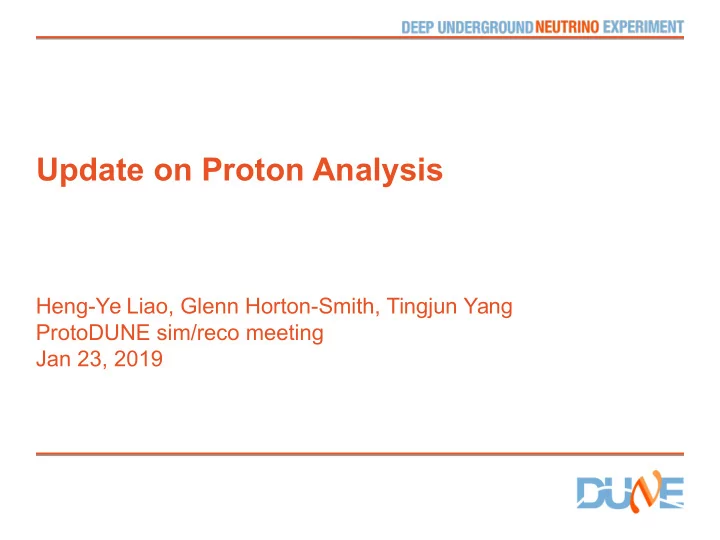

Update on Proton Analysis Heng-Ye Liao, Glenn Horton-Smith, Tingjun Yang ProtoDUNE sim/reco meeting Jan 23, 2019 You Inst Logo You Inst Logo
Outline • Calorimetric reconstruction of 1 GeV/c protons - Data sample & event selection - dQ/dx to dE/dx calibration - dE/dx versus residual range for both data and MC - Performance of the calorimetric reconstruction • Proton analysis with different cathode voltage configurations - Selection of data sample 2 Presenter Name | Presentation Title You Inst Logo You Inst Logo
Data Sample & Event Selection • Data sample : Run 5387 [1 GeV/c] / 180 kV / ~5 msec • Use Pandora algorithm for reconstruction • Event selection cuts: - Details of the cuts can be found in my previous talk: https://indico.fnal.gov/event/19376/contribution/2/material/slides/0.pdf - Cuts that have been used + Angle cut + Position cut: start positions of primary tracks & beam positions + Ratio cut (track length/CSDA) to select the stopping protons 3 Presenter Name | Presentation Title You Inst Logo You Inst Logo
Calibration • Get dQ/dx information from the PFpartice associtation • Calibration: dQ/dx → dE/dx • Calibration work all done by Ajib! • Calibration procedure: - Use TPC crossing tracks for the dQ/dx distribution - Correct the non-uniform dQ/dx distribution caused by both attenuation and SCE to the uniform dQ/dx distribution (calibration along x-direction) - Use the stopping muons as a standard candle to convert dQ/dx to dE/dx (using the modified box model*) - Details of Ajib’s work on calibration can be found: https://indico.fnal.gov/event/19132/contribution/1/material/slides/0.pdf *Reference: “A study of electron recombination using highly ionizing particles in the ArgoNeuT Liquid Argon TPC” (https://arxiv.org/abs/1306.1712) 4 You Inst Logo You Inst Logo
Proton dE/dx Versus Residual Range • Theoretical predition for proton dE/dx versus residual range (shown in red): Landau-Vavilov distribution (work done by Ajib) 5 You Inst Logo You Inst Logo
Data & MC Comparison You Inst Logo You Inst Logo 6
dE/dx – Data & MC • MC (SCE ON) agrees well with data! • dE/dx peak position: Data/SCE OFF/SCE/SCE+FLF 3.88/3.31/3.83/3.3 7 [MeV/cm] You Inst Logo You Inst Logo 7
Calorimetric Reconstruction • Apporaches to measure proton kinetic energy: (1) Beam instrumentation (source) P beam (beam momentum) → KE beam (beam kinetic energy) (2) Reconstructed track length of the stopping protons* Track length → KE range (3) Reconstructed kinetic energy of the stopping protons (sum over all hits) KE calo = • Benchmark quantities of the reconstruction (1) KE range /KE beam (2) KE calo /KE beam (3) KE calo /KE range *Reference: NIST Data base You Inst Logo You Inst Logo 8 (https://physics.nist.gov/PhysRefData/Star/Text/PSTAR.html)
Calorimetric Reconstruction Mean FWHM [GeV] [GeV] KE beam 0.398 0.102 KE range 0.356 0.103 KE calo 0.361 0.122 You Inst Logo You Inst Logo 9
Benchmark Quantities Benchmark Mean Sigma Quantity KE range /KE calo 0.974 0.043 KE calo /KE beam 0.928 0.045 KE range /KE beam 0.896 0.055 • The calo-based reco is well consistent with the range-based reco • Calorimetric reconstruction works very well You Inst Logo You Inst Logo 10
Proton analysis – High Voltage Effect • Cathode voltage affects both attenuation & recombination - Low voltage may have a worse S/N performance and SCE may get worse with a lower cathode voltage → Check data first! • Kick-off analysis - Selection of two data samples which have the same Argon purity but with different cathode voltages → Run 5308 (180 kV) Run 5303 & 5304 (140 kV) You Inst Logo You Inst Logo 11
Angle-corrected SNR Notes: [1] Lifetime: Value extracted from the top purity monitor You Inst Logo You Inst Logo 12 [2] Definition of SNR: See https://indico.fnal.gov/event/19015/contribution/5/material/slides/0.pdf
Summary & Outlook • We have made the dE/dx calibration for the 1 GeV/c proton data • MC dE/dx distribution with SCE ON matches data well • Offset between the measured and the theoretical predicted curve for the dE/dx-versus-residual range • The calorimetric reconstruction seems to work very well • Kick-off proton analysis with different cathode voltages • Next: -Calorimetric reconstruction of MC -Re-processing the reco files of the 140 kV data -Work on analyzing the new 140 kV reco files You Inst Logo You Inst Logo 13
Recommend
More recommend